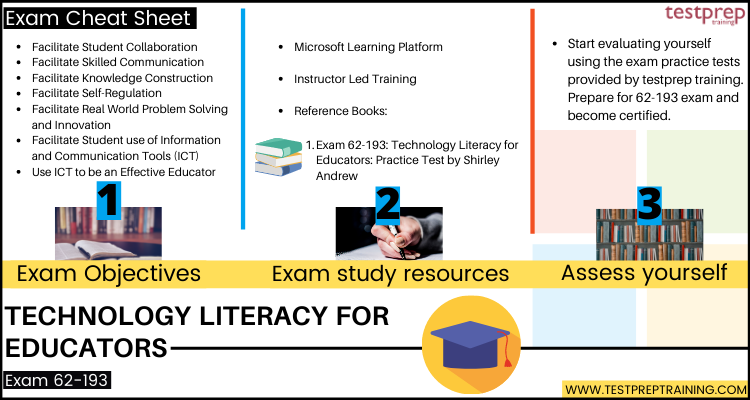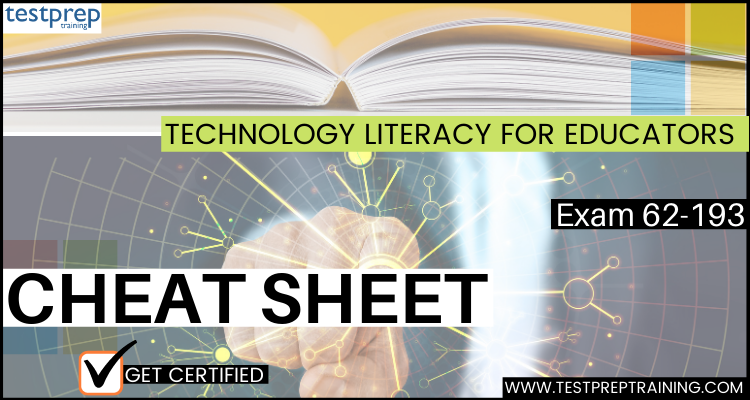Ready to have a quick revision for the Microsoft 62-193 exam? This cheat sheet serves as a quick summary for the Microsoft Certified Educator (62-193) exam, encompassing all the vital information and necessary resources to successfully pass the examination. It is quite common that sometimes it gets confusing during the last minute preparation time for where to start. This cheat sheet is created to clear out this confusion. In other words, you will be able to revise everything in a sequential manner for the Microsoft Certified Educator (62-193) exam. And, the other big advantage of this cheat is that it is divided into sections starting with the basic exam requirements and ending with the essential study resources so that everything will not get mixed up.
However, in order to get a full understanding of the Microsoft Certified Educator (62-193) exam, it is important to have knowledge of the basic details and requirements. So, without wasting any time let’s start with let’s get started with the 62-193 exam basic requirements and overview.
Microsoft Certified Educator (62-193): Exam Overview
The Microsoft 62-193 certification is a component of the Microsoft Certified Educator (MCE) program, which is an intermediate-level assessment designed to assess competencies aligned with the 21st Century Learning Design (21CLD) framework, ensuring validity and reliability. Successful candidates in the Microsoft Certified Educator (62-193) Exam earn the Microsoft Certified Educator (MCE) certification. Regarding the exam itself, it verifies that educators possess the worldwide technology literacy competencies necessary to deliver a personalized and enriching learning experience for their students.
You must know that Microsoft has also provided a list of people who are best fit for this exam. Below, you can have a look at it.
This exam is best suitable for:
- Firstly, for those who are preparing to become classroom educators
- Secondly, Current educators
- Thirdly, Faculty at teacher training or pre-service colleges
- Then, Educational administrators
- Lastly, professionals looking to provide validation of competency
Further, for Microsoft Certified Educator (62-193) exam there are learning objectives that you will be able to gain from this exam.
Microsoft 62-193: Learning Objectives
Microsoft provides learning exam objectives for the 62-193 exam that will help you understand and give you idea about the basic concepts. And, these exam concepts are provided with sections and subsections to make you learn about it in depth. However, for the Microsoft 62-193 exam the basic concepts you will learn about include:
- Firstly, Advancing communication skills
- Secondly, Student collaboration
- Thirdly, Simplifying knowledge construction
- Then, Working on self-regulation
- After that, Assisting in real-world problem solving and innovation
- Lastly, Using ICT to be an Effective Educator
Microsoft Certified Educator (62-193) Cheat Sheet
Within the cheat sheet for the Microsoft Certified Educator (62-193) exam, we will address the most important learning resources available for your comprehensive revision. This encompasses the Microsoft Certified Educator 62-193 study guide and a collection of valuable links that directly lead you to resources relevant to the exam, assisting in resolving any uncertainties you may have. Let’s commence with the guide and enhance your preparation process.

Understand the exam objectives
This cheat sheet primarily aims to offer a brief review of the information you are already familiar with. The crucial initial step is to begin with an understanding of the exam objectives for the 62-193 exam. This approach will immerse you in the subjects and competencies covered by the 62-193 exam. Furthermore, the exam objectives can assist you in reinforcing your knowledge of the modules and their corresponding subtopics. For the Microsoft Certified Educators (62-193) exam, below we will learn about the important topics. This include:
Topic 1: Facilitate Student Collaboration
1.1 Determining the level in which a learning activity meets the rubric for collaboration
- Firstly, preparing activities that enable students to work together, have a shared responsibility for deliverables, make decisions that are substantive and crucial to learning activity success, and work interdependently.
- Then, analyzing, evaluating, designing, and managing the learning environment to facilitate student collaboration, given a set of resources available in a classroom.
- virtual environment; physical environment; software tools available.
Topic 2: Facilitate Skilled Communication
2.1 Modifying learning activity to meet the rubric for the highest level of skilled communication
- preparing activities that enable students to create product deliverables that convey a set of connected ideas, are multimodal, require supporting evidence, and are designed for a specific audience.
2.2 Evaluating student product examples for determining the level to which they meet the skilled communication rubric
- evaluating student product examples on the use of connected ideas, multimodal approach, supporting evidence, and design for a specific audience.
Topic 3: Facilitate Knowledge Construction
3.1 Determining the level to which a learning activity meets the knowledge construction rubric
- prepare interdisciplinary activities that enable students to apply knowledge in a new context.
3.2 Transforming a didactic learning situation into an activity that requires students to apply knowledge in a new context that facilitates interdisciplinary learning
- preparing activities that enable students to spend their time and effort in developing knowledge that is new to them and participate in interdisciplinary learning activities.
Topic 4: Facilitate Self-Regulation
4.1 Determining the level to which a learning activity meets the rubric for self-regulation
- preparing long-term activities that enable students to plan their own work and revise work based on feedback.
4.2 Verifying which opportunities facilitate an environment of self-regulation
- Firstly, providing students with opportunities to set their learning goals
- Secondly, deciding on the best strategies to achieve these goals
- Lastly, monitoring to see if these strategies are working.
Topic 5: Facilitate Real World Problem Solving and Innovation
5.1 Determining the level to which a learning activity meets the rubric for real world problem solving
- preparing activities that enable students to develop a solution to a problem that is new to them (Microsoft Documentation:
- completing a task that has not been instructed how to do
- designing a complex product that meets a set of requirements.
5.2 Selecting strategy for encouraging students to problem-solve, innovate, and apply a solution that benefits others in the real world
- developing learning objectives that involve real-world issues. (Microsoft Documentation:
Topic 6: Facilitate Student use of Information and Communication Tools (ICT)
6.1 Determining the level to which a learning activity meets the rubric for use of ICT learning
- preparing activities that enable students’ use of ICT to support knowledge construction
6.2 Fulfilling student learning outcomes by using Microsoft technology tools
- identifying the skills required to implement the resources.
6.3 Selecting the best ICT resource to help resolve or manage the logistical challenges of reaching the desired educational outcome
- configuration issues in Lab
- Then, shared computers
- Lastly, BYOD
Topic 7: Use ICT to be an Effective Educator
7.1 Verifying which ICT resource supports a specified educational outcome
- evaluating a learning activity; rate the appropriateness of specific ICT resources; address the diverse needs of all learners.
7.2 Determining the appropriate pedagogical approach to meet an educational outcome using ICT resources
- planned vs. unplanned situations
- appropriate performances of understanding
- different learning styles
7.3 Selecting an appropriate ICT resource to reach a professional development goal
- improving productivity
- time management skills
7.4 Evaluating responses to a scenario involving Digital Citizenship
- internet safety
- security issues
- cyber-bullying
- digital footprint
- privacy issues
- communication forums
- acceptable use
Prepare for Microsoft Certified Educator exam using 62-193 Study Guide!
Microsoft Learning Platform
The learning platform by Microsoft gives you access to get information about the exam using the learning resources. For the Microsoft Certified Educator 62-193 exam, these study resources can be accessed from the official exam page. Furthermore, it’s advisable to visit the official Microsoft website to access reliable information about the exam. You can easily find the 62-193 exam page, which provides comprehensive details about the examination.
Instructor-led Training
Microsoft provides Instructor-led training that covers central elements of the 62-193 exam in which you will be able to understand the key components of the exam. Moreover, this training will help you to advance your communication skills, Knowledge Construction, Self-Regulation and Real-World Problem Solving and Innovation. And, further, help you to become Microsoft Certified Educator.,
Using Reference Books
Books are incredibly valuable during the revision process, as they enable you to quickly locate and learn about specific topics of interest. In the context of the 62-193 exam, there are several highly regarded books that have been prominent in the market for years. You can utilize these books as references for your study. Here are some of the noteworthy Microsoft Certified Educator 62-193 exam books:
- Exam 62-193: Microsoft Certified Educator: Practice Test by Shirley Andrew
Assess yourself with Practice Tests
Practice tests are essential for more effective preparation because they allow you to assess your strengths and weaknesses. You can initiate the practice of taking Microsoft Certified Educator 62-193 practice exams, which will not only help in self-assessment but also enhance your ability to answer questions efficiently, ultimately saving you time. It’s advisable to begin practicing these tests after completing an entire topic, as this provides a valuable review. Lastly, ensure you study diligently to succeed in the exam.



